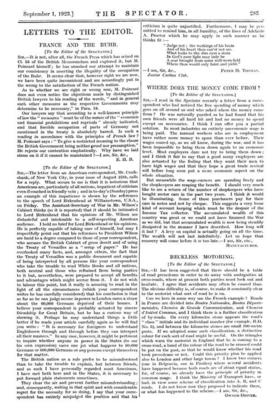RECKLESS MOTORING.
iTo the Editor of tlw SPECTATOR.] SIR,—It has been suggested that there should be a table of road precedence in order to do away with ambiguities at cross-roads, where at present both parties must look out and hesitate. I agree that accidents may often he caused thus. The obvious difficulty is, of course, to make it constantly clear to the motorist what sort of road he is on.
Can we here in some way use the French example ? Roads in France are divided into Routes Nationales, Routes Departe- tnentales, Chemins de Grande Communication, and Chemins d'Interet Comnzun, and I think there is a further classification of by-roads. On every kilometre stone appears the road's " class " initials and its individual number (for example, R.D. No. 3), and between the kilometre stones are small 100-metre posts. If we adopted sonic such classification, a distinctive colour for each sort of road might be useful. On the triangles which warn the motorist in England that he is -coming to a cross-road, a band of the colour of the road to be crossed could be put on the post, so that he would know whether his road took precedence or not. Could this priority plan be applied also to London and other large towns ? 1 know two corners (one in Belgravia, one in Pimlico) where several accidents have happened because both roads arc of about equal status, for, of course, we already have the principle of priority in common usage. I think the Ministry of Transport have, or had, in view some scheme of classification into A, B, and C roads. I do not know how they proposed to indicate these, or what has happened to the scheme.—I am, Sir, &c.,
OwNER-DnivEa.


































 Previous page
Previous page